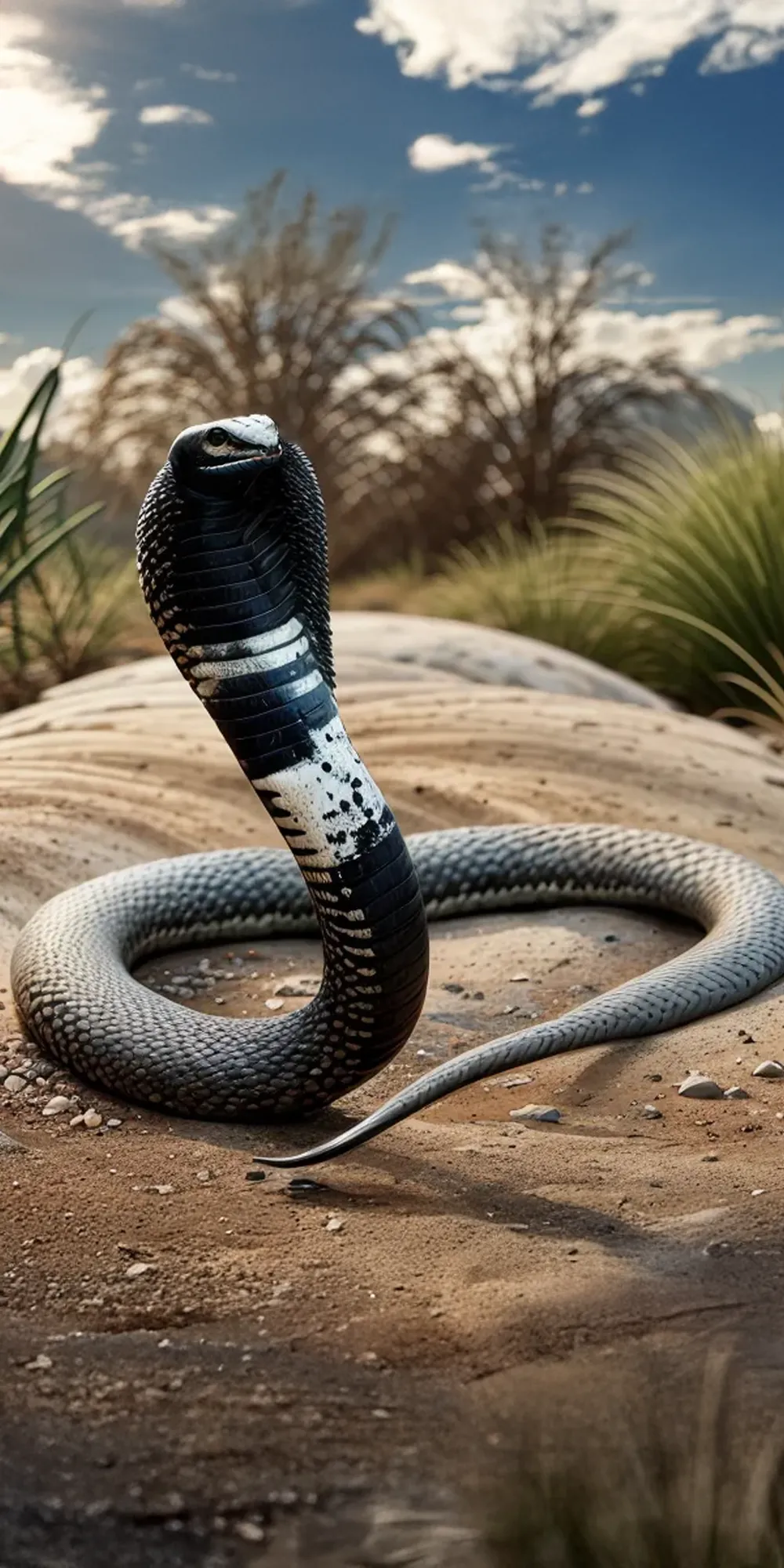The Rinkhals
The Rinkhals, also known as the Ring-necked Spitting Cobra, is a venomous snake native to southern Africa. It is easily recognized by its distinct ringed neck pattern and its ability to spit venom as a defense mechanism. This snake can grow up to 1.2 meters in length and has black scales with yellow or white rings around its neck. Despite its potentially dangerous venom, the Rinkhals often prefers to flee rather than attack when threatened.

| Rinkhals | |
|---|---|
| Size | Average length of 1.2 meters (120 cm) |
| Weight | Average weight of 400 grams |
| Speed | 6-9mph (10-14km/h) |
| Key Strength | Venomous bite |
| Biggest Weakness | Does not raise hood |
| Scientific Name | Hemachatus haemachatus |
| Family | Elapidae |
| Habitat | Grasslands, savannas, and marshes |
| Geography | Southern Africa |
| Diet | Small mammals, birds, eggs |
| Lifespan | 6 years - 8 years |

The Rinkhals
The Rinkhals, also known as the Ring-necked Spitting Cobra, is a venomous snake native to southern Africa. It is easily recognized by its distinct ringed neck pattern and its ability to spit venom as a defense mechanism. This snake can grow up to 1.2 meters in length and has black scales with yellow or white rings around its neck. Despite its potentially dangerous venom, the Rinkhals often prefers to flee rather than attack when threatened.
Fun Fact: Rinkhals have the unique ability to spit their venom accurately up to two meters away to deter predators or threats, making them one of the few snake species with this defensive mechanism.
| Rinkhals | |
|---|---|
| Size | Average length of 1.2 meters (120 cm) |
| Weight | Average weight of 400 grams |
| Speed | 6-9mph (10-14km/h) |
| Key Strength | Venomous bite |
| Biggest Weakness | Does not raise hood |
| Scientific Name | Hemachatus haemachatus |
| Family | Elapidae |
| Habitat | Grasslands, savannas, and marshes |
| Geography | Southern Africa |
| Diet | Small mammals, birds, eggs |
| Lifespan | 6 years - 8 years |
Rinkhals Matchups
We use AI to simulate matchups between the Rinkhals and other animals. Our simulation considers size, strength, and natural predatory behaviors to determine the most likely outcome.
Rinkhals: Diet, Predators, Aggression, and Defensive Behaviors
What do Rinkhals eat?
Rinkhals primarily feed on amphibians, such as frogs and toads, as well as small mammals, birds, and reptiles. They are known to have a varied diet depending on their habitat and the availability of prey.
Do Rinkhals have any predators?
Rinkhals are preyed upon by birds of prey, such as eagles and hawks, as well as other snakes, including the Cape cobra. Juvenile Rinkhals may also fall victim to larger predators like mongooses and monitor lizards.
Are Rinkhals aggressive?
Rinkhals are known for their defensive behavior and can be aggressive when threatened. They are quick to defend themselves by hissing loudly, spreading their hoods, and striking repeatedly. However, they will usually try to escape if given the opportunity.
Do Rinkhals fight?
Rinkhals are not typically territorial and do not engage in fights with other snakes unless it is for mating purposes or defense. They may engage in combat dances during the breeding season to establish dominance and access to mating partners.
How do Rinkhals defend themselves?
Rinkhals have several defensive mechanisms to protect themselves from predators. They are capable of spraying a potent neurotoxic venom from their fangs, which can cause severe pain and even paralysis if it enters the bloodstream. They also use their intimidating displays, such as hissing and hooding, to deter threats.
What is the biggest weakness of Rinkhals in a fight?
Despite their potent venom and defensive behaviors, Rinkhals have relatively small fangs compared to other venomous snakes, which can make it harder for them to deliver a substantial amount of venom in a single bite. Additionally, their strikes are often more speculative in nature, increasing the chances of a failed attack on their prey or predator.
Fun Fact: The Rinkhals is known for its behavior of playing dead when feeling threatened, which can confuse predators and give it a chance to escape to safety.
Fun Fact: Unlike other snake species, the Rinkhals is an ovoviviparous reptile, meaning it gives birth to live young rather than laying eggs, with each litter usually consisting of around 20-30 offspring.










